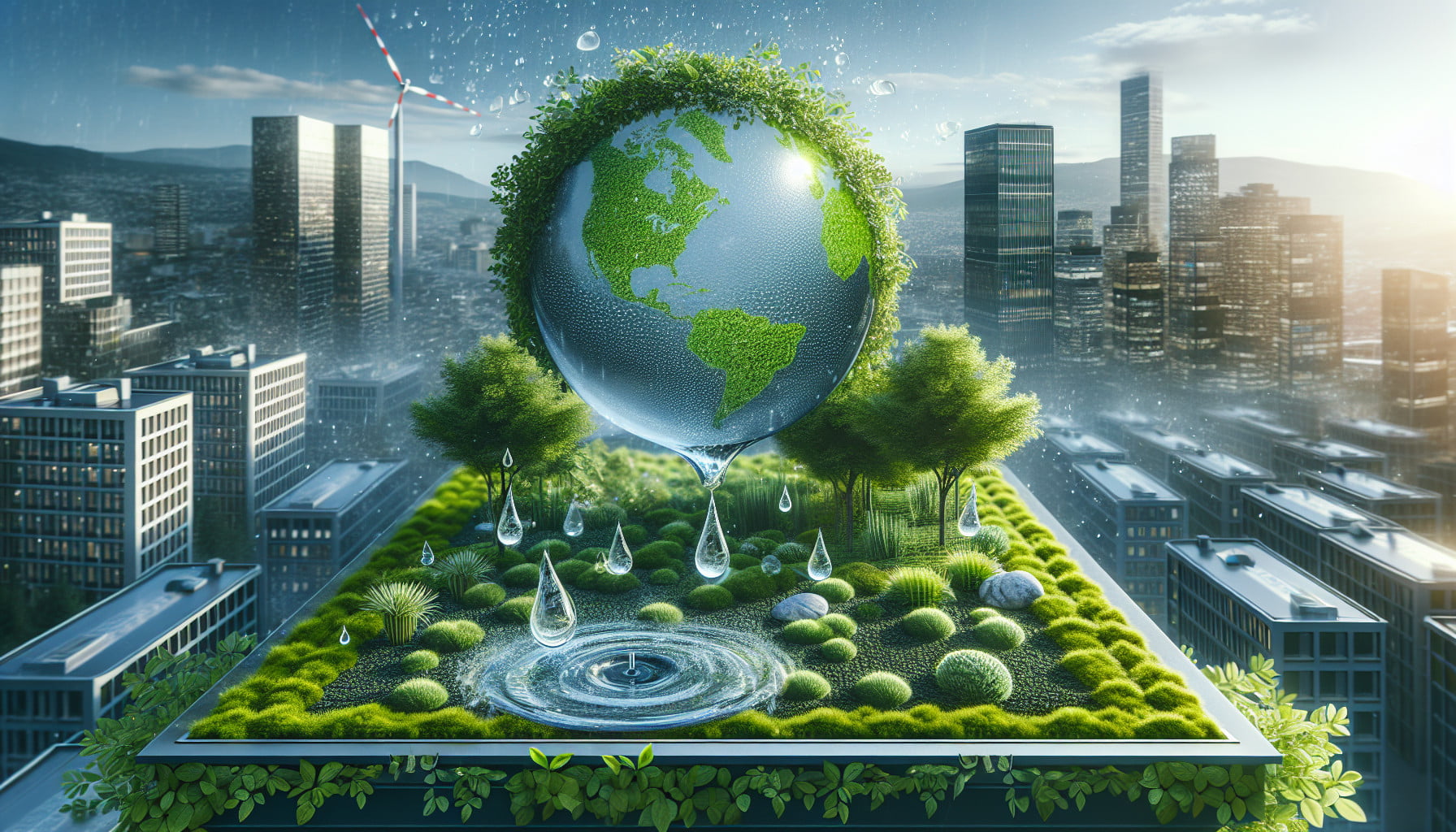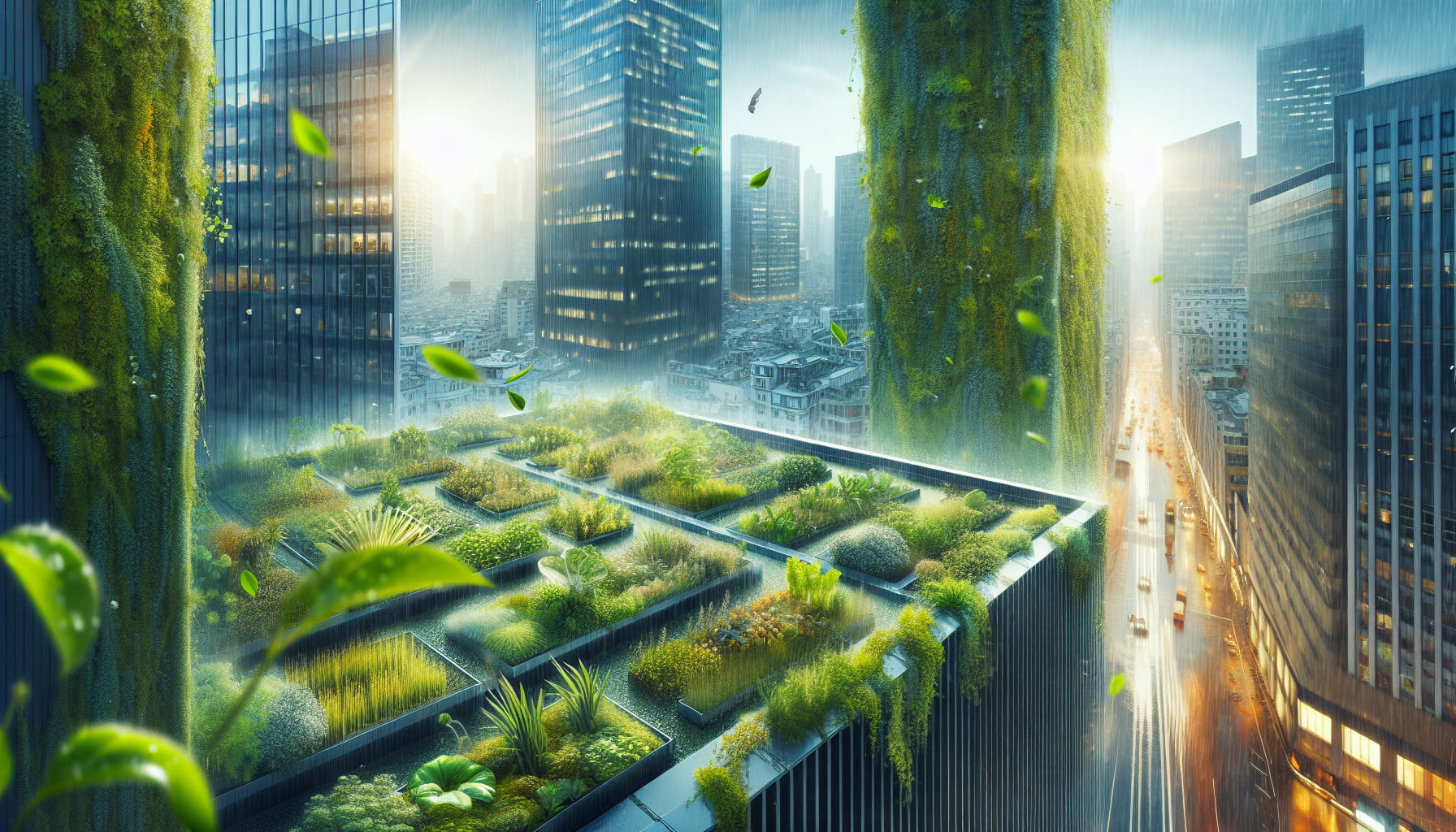Did you know green roofs could be the answer to mitigating stormwater runoff? With the increasing frequency of heavy rainstorms and the strain it puts on urban infrastructure, finding sustainable solutions is becoming more important than ever. Green roofs, also known as eco-roofs or living roofs, are effective in reducing stormwater runoff by absorbing and retaining rainwater. In addition to their environmental benefits, they also provide insulation, reduce energy consumption, and create a habitat for flora and fauna. So, if you’re wondering how to tackle stormwater runoff in a sustainable and efficient way, green roofs might just be the answer you’ve been looking for.
Benefits of Green Roofs for Stormwater Management
Green roofs offer numerous benefits when it comes to managing stormwater runoff. By implementing green roofs, you can reduce the amount of stormwater that flows into drainage systems, leading to a decrease in flooding and related issues.
Reduced Stormwater Runoff
One of the key benefits of green roofs is their ability to reduce stormwater runoff. When it rains, green roofs absorb a significant amount of the water through their vegetation and growing medium. This absorption minimizes the volume of runoff that enters the drainage system, alleviating the pressure on stormwater infrastructure and reducing the risk of flooding.
Improved Water Quality
Another advantage of green roofs is their contribution to improved water quality. As the rainwater passes through the growing medium and vegetation, it undergoes a natural filtration process. This helps to remove pollutants and impurities, resulting in cleaner water that eventually reaches the drainage system.
Decreased Urban Heat Island Effect
Green roofs also play a role in mitigating the urban heat island effect, which is the phenomenon of cities being hotter than the surrounding rural areas. By covering rooftops with vegetation, green roofs help to cool the air and create a more comfortable urban environment. This cooling effect reduces the demand for air conditioning, which in turn reduces energy consumption and greenhouse gas emissions.
Components of Green Roofs
To successfully manage stormwater, green roofs incorporate various components that work together seamlessly.
Vegetation
The vegetation on a green roof serves multiple purposes. Firstly, it helps to absorb rainwater, reducing the runoff. Secondly, it plays a crucial role in the evapotranspiration process, where the plants release water vapor into the atmosphere, further reducing the overall volume of stormwater. The choice of vegetation depends on factors such as climate, site conditions, and desired aesthetics.
Growing Medium
The growing medium, or soil, on a green roof is specifically designed to provide the necessary nutrients and support for plant growth. It should have good water retention properties while still allowing for proper drainage to prevent waterlogging. The composition of the growing medium should be carefully considered to ensure its suitability for vegetation and stormwater management.
Drainage System
An effective drainage system is integral to green roofs for stormwater management. It helps to facilitate the controlled flow and discharge of excess rainfall. This system typically consists of drain pipes, gutters, and outlets that help direct the water either back into the environment or to storage for later use.
Waterproof Membrane
The waterproof membrane is a vital component of green roofs as it prevents moisture from penetrating the structural roof. It acts as a barrier between the growing medium and the roof structure, ensuring that water is directed towards the drainage system rather than seeping into the building.
Root Barrier
The root barrier is an important feature that prevents plant roots from causing damage to the roofing structure. It restricts the growth of roots beyond a certain depth and ensures that the integrity of the waterproof membrane and roof structure is maintained over time.

Mechanisms of Stormwater Mitigation
Green roofs employ various mechanisms to mitigate stormwater runoff effectively.
Retention
Retention is the process of storing and holding stormwater on the green roof rather than allowing it to immediately run off. Green roofs achieve retention through multiple means.
Detention
Detention involves temporarily holding and delaying the release of stormwater runoff from the green roof. This delay allows for gradual discharge into the drainage system, reducing the intensity of peak flows and minimizing strain on infrastructure.
Evapotranspiration
Evapotranspiration is a natural process through which water is lost from plants and soil through transpiration and evaporation. Green roofs leverage the evapotranspiration mechanism to remove stormwater from the system. This process aids in reducing the overall volume of runoff by turning excess precipitation into water vapor.
Retention of Stormwater
Retention is a crucial mechanism in stormwater management on green roofs. Several factors contribute to the retention of stormwater.
Vegetation Absorption
The vegetation on a green roof absorbs a significant proportion of rainwater. The plants’ leaves and stems act as surfaces that intercept and retain rainfall. This absorption reduces the volume of runoff that eventually makes its way to the drainage system.
Growing Medium Retention
The growing medium has excellent water retention properties, holding onto rainfall and preventing immediate runoff. The composition of the growing medium is carefully designed to strike the right balance between water retention and drainage.
Increased Soil Moisture
By retaining stormwater on the green roof, the soil moisture level increases. This moisture benefits the vegetation, allowing the plants to thrive and contribute to the overall stormwater management process.

Detention of Stormwater
Detention is an important aspect of stormwater management, as it helps control the flow and release of water from green roofs. The following mechanisms aid in the effective detention of stormwater.
Water Storage Capacity
Green roofs are designed to have a specific water storage capacity, ensuring that excess rainwater can be stored temporarily before gradual discharge. The design and specification of this capacity take into account factors such as rainfall patterns, plant water requirements, and site conditions.
Slow Release of Runoff
By slowing down the release of stored stormwater, green roofs prevent sudden surges in runoff volume. The gradual release reduces the pressure on drainage systems, ensuring a more consistent flow rate and minimizing the risk of overloading existing infrastructure.
Evapotranspiration of Stormwater
Evapotranspiration plays a significant role in stormwater management on green roofs. The following mechanisms contribute to the evapotranspiration process.
Water Loss via Plant Transpiration
Plants on green roofs undergo transpiration, which is the process of losing water vapor through their leaves. This loss of water vapor helps to reduce the overall volume of stormwater on the roof, contributing to effective stormwater management.
Cooling Effect
Evaporative cooling is an additional benefit of the evapotranspiration process. As water is lost through transpiration, it cools the surrounding air, creating a lowered air temperature. This cooling effect helps to mitigate the urban heat island effect and create a more comfortable environment.
Design Considerations for Effective Stormwater Management
To ensure effective stormwater management on green roofs, various design considerations should be taken into account.
Slope and Roof Structure
The slope and structure of the roof play a crucial role in stormwater management. The angle of the slope should be carefully designed to allow for proper drainage while taking into consideration factors such as local climate and rainfall patterns. The roof structure should be able to support the additional load of the green roof and the retained stormwater.
Vegetation Selection
The selection of vegetation is essential for efficient stormwater management. Native or adaptive plants that are well-suited to the local climate and have deep root systems tend to be ideal choices. These plants can better withstand extreme weather conditions and contribute to better stormwater absorption and retention.
Growing Medium Composition
The composition of the growing medium is critical to ensure optimal stormwater management. It should have the right balance of water retention and drainage properties. Factors such as particle size, organic content, and nutrient levels should be considered when designing the growing medium.
Drainage System Design
An effective drainage system is necessary to prevent any waterlogging issues and to facilitate the controlled flow of stormwater. The design should include appropriate drainpipes, gutters, and outlets that ensure efficient discharge of excess rainwater.
Case Studies on Green Roofs and Stormwater Mitigation
Several successful case studies demonstrate the effectiveness of green roofs in stormwater management.
Chicago City Hall Green Roof
The green roof installed on the Chicago City Hall has proven to be an excellent example of stormwater runoff reduction. The roof’s design includes a combination of plant species that help absorb and retain rainfall. It has played a significant role in reducing the burden on the city’s stormwater infrastructure and has become a model for green roof implementation.
High Line Park, New York City
The green roof on the High Line Park in New York City has been instrumental in stormwater management. The park’s design incorporates a combination of meadow-like vegetation that aids in the absorption and retention of rainwater. The green roof has not only reduced stormwater runoff but also enhanced the overall aesthetic and biodiversity of the park.
Olympic Village, Vancouver
During the construction of the Olympic Village in Vancouver, green roofs were implemented to manage stormwater runoff effectively. These green roofs have proven to be instrumental in reducing the impact of heavy rainfall events and minimizing the strain on the city’s drainage infrastructure. The Olympic Village showcases how green roofs can play a key role in stormwater management on a larger scale.
Challenges and Limitations
While green roofs offer numerous benefits for stormwater management, there are also certain challenges and limitations to consider.
Structural Load
The additional weight of the green roof and the retained stormwater can pose structural load challenges. The roof structure must be able to withstand this additional weight safely. Structural assessments and reinforcements may be necessary to ensure the long-term integrity of the building.
Maintenance Requirements
Green roofs require ongoing maintenance to ensure their effectiveness in stormwater management. This includes regular inspections, irrigation, fertilization, and weed control. Adequate resources and a maintenance plan need to be in place to ensure the continued performance of the green roof.
Initial Installation Cost
The initial installation cost of a green roof can be higher compared to traditional roof systems. Factors such as specialized materials, design considerations, and additional labor can contribute to the higher upfront expense. However, it is important to consider the long-term benefits and cost savings associated with stormwater management.
Climate and Suitability Constraints
The climate and suitability of a particular location may impose limitations on the effectiveness of green roofs for stormwater management. Factors such as extreme temperatures, water availability, and plant adaptability need to be taken into account when evaluating the feasibility of green roof implementation.
Incentives and Policies Promoting Green Roof Implementation
To encourage the adoption of green roofs for stormwater management, various incentives and policies are in place.
Stormwater Fee Reduction
Some municipalities offer stormwater fee reductions or credits to buildings that implement green roofs. These incentives help offset the initial installation cost and incentivize property owners to invest in green roof technology.
Green Roof Tax Credits
Certain jurisdictions provide tax credits to property owners who install green roofs. These tax incentives help reduce the financial burden and promote the widespread adoption of green roofs for stormwater management.
Mandatory Green Roof Requirements
In some areas, local building codes or planning regulations include mandatory green roof requirements. These policies ensure that new construction or major renovations incorporate green roofs as part of their stormwater management strategies. This approach helps to mainstream the use of green roofs and increase their overall impact.
In conclusion, green roofs offer a range of benefits for stormwater management, including reduced runoff, improved water quality, and decreased urban heat island effect. By understanding the components of green roofs and the mechanisms they employ, effective stormwater mitigation can be achieved. Design considerations, case studies, and incentives further highlight the significance of green roofs in managing stormwater runoff. While challenges and limitations exist, the potential for green roofs to contribute to sustainable stormwater management is significant.
